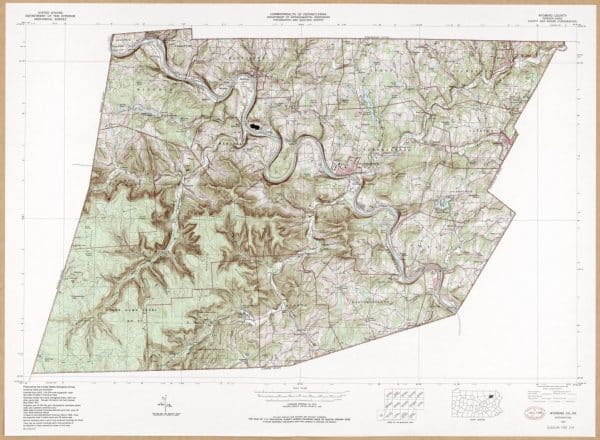History
Wyoming County was formed out of the northern part of Luzerne, by an act of Assembly approved April 4th, 1842. When the petition for its organization was presented to the Legislature, the Petitioners asked that it might be called “Putnam”, the name of one of the certified townships in the county. Through the influence of a member from Luzerne County, the name Wyoming was substituted for Putnam, and thus the act passed. Henry Colt of Luzerne County, George Mack of Columbia County and John Boyle of Susquehanna County were appointed commissioners to survey and mark the boundary lines of the county.
By a supplementary act approved June 28th the same year, the boundaries were established and it was ordered that three commissioners be appointed by the governor to locate the county seat. The act also provided for the election of county officers on the second Tuesday in October, 1842; and until such officers were elected and qualified the government of Wyoming was to be administered by the officers of Luzerne County.
The commissioners appointed to locate the county seat were Hendrick B. Wright of Luzerne County, S. J. Headly of Columbia County and Thomas Gratton of Monroe. These commissioners in the autumn of 1842 determined on Tunkhannock as the County Seat. The land for the public buildings was donated to the county by Thomas T. Slocum. The first court house and jail were erected in 1843 and cost about $5000.00 to build. The funds used were raised by subscription among the citizens of Tunkhannock and vicinity.

The buildings were erected under supervision of a committee appointed by the subscribers and afterward turned over to the county commissioners by whom they were furnished at the expense of the county. The contractor who built them was Thomas H. Parker. They were brick structures which were the first brick structures built in the borough. The court house was forty feet square and two stories tall. The second floor was wholly used as a court room and the public offices and jury room were on the first floor. The first session of the court held in this house was in 1844. Previous sessions had to be held in the Methodist and Presbyterian churches. The public offices were kept in a building on what then was known as Turnpike street. This building was subsequently taken down to make way for the canal.
The jail, which stood about 150 feet in the rear of the court house, had a stone basement, in which were four cells for prisoners and a super structure of brick for the sheriff. It was first occupied as a prison in 1844. The second jail was erected in 1866, on the west side of Slocum Street. It was made of stone, one story in height, with a brick front of two stories for a sheriff’s residence. The jail was 33′ x 35′. It had 6 cells and had a capacity for ten prisoners. The cost was $15,520.00, including extras. C. W. Lung was the architect and Charles Place the contractor.
In 1869, by the authority of the Legislature, the County issued bonds to the amount of $15,000.00 for the repair of the courthouse and improvements of the public grounds. On May 15, 1869, a contract was given John W. Crawford for the repair of the old courthouse and the building of the new front, constituting in fact almost a new structure, for the sum of $18,980. The actual cost of the building which was completed by Charles Place, the surety of the contractor, was $24,880.00, the additional amount being for extra work directed by the commissioners. The building was completed and accepted in 1870. The front was 76 by 40, three stories high, with a rear projection of two stories, 70 feet square. The whole is of brick, covered with cement. The architect was D. H. Nott. While the courthouse was in process of repair the court was held in the basement of the Methodist Church. The public offices were kept in the second story of Little’s building, on the east side of Warren Street.
